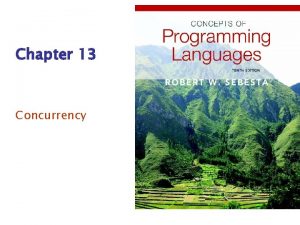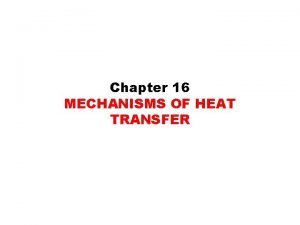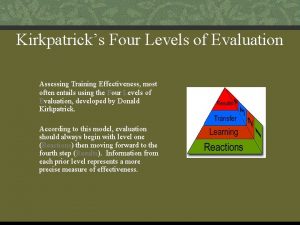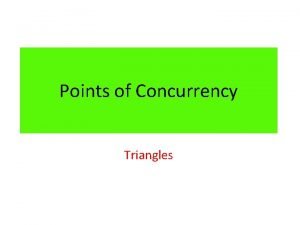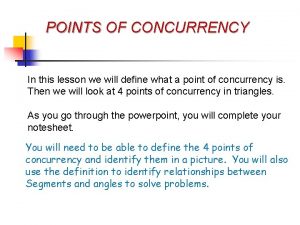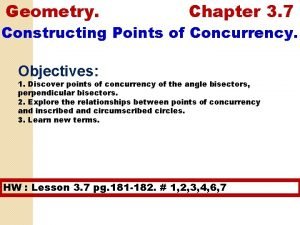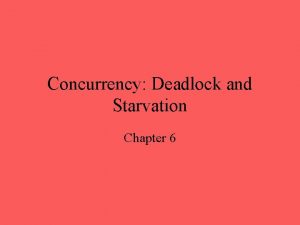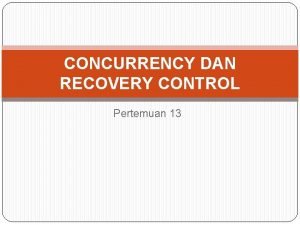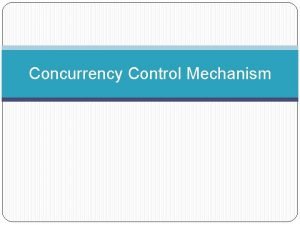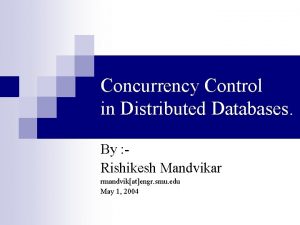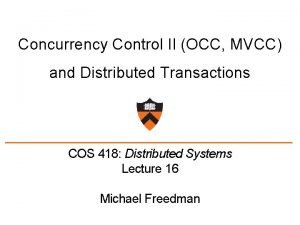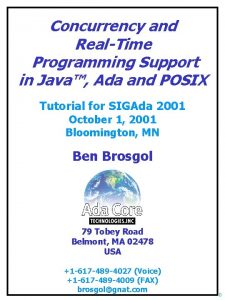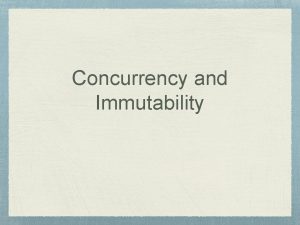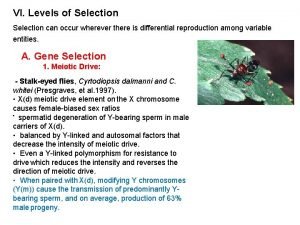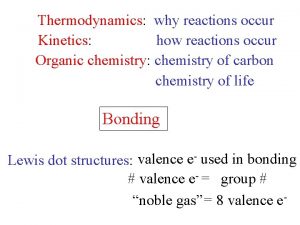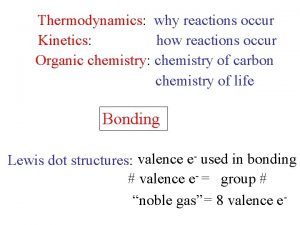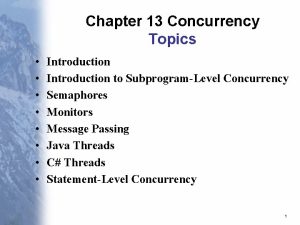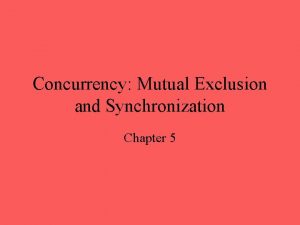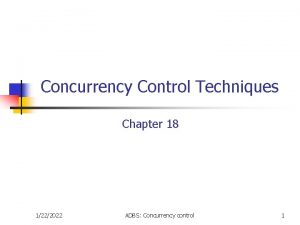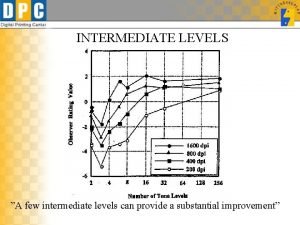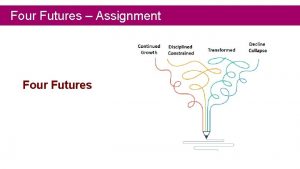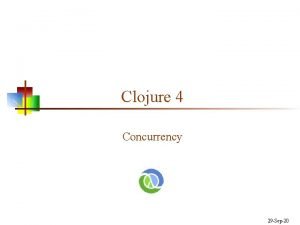Chapter 12 Concurrency can occur at four levels




























- Slides: 28

Chapter 12 Concurrency can occur at four levels: 1. Machine instruction level 2. High-level language statement level 3. Unit level 4. Program level Because there are no language issues in instruction- and program-level concurrency, they are not addressed here The Evolution of Multiprocessor Architectures 1. Late 1950 s - One general-purpose processor and one or more special-purpose processors for input and output operations 2. Early 1960 s - Multiple complete processors, used for program-level concurrency 3. Mid-1960 s - Multiple partial processors, used for instruction-level concurrency 4. Single-Instruction Multiple-Data (SIMD) machines The same instruction goes to all processors, each with different data - e. g. , vector processors Copyright © 1998 by Addison Wesley Longman, Inc. 1

Chapter 12 5. Multiple-Instruction Multiple-Data (MIMD) machines - Independent processors that can be synchronized (unit-level concurrency) Def: A thread of control in a program is the sequence of program points reached as control flows through the program Categories of Concurrency: 1. Physical concurrency - Multiple independent processors ( multiple threads of control) 2. Logical concurrency - The appearance of physical concurrency is presented by timesharing one processor (software can be designed as if there were multiple threads of control) - Coroutines provide only quasiconcurrency Copyright © 1998 by Addison Wesley Longman, Inc. 2

Chapter 12 Reasons to Study Concurrency 1. It involves a new way of designing software that can be very useful--many real-world situations involve concurrency 2. Computers capable of physical concurrency are now widely used Fundamentals (for stmt-level concurrency) Def: A task is a program unit that can be in concurrent execution with other program units - Tasks differ from ordinary subprograms in that: 1. A task may be implicitly started 2. When a program unit starts the execution of a task, it is not necessarily suspended 3. When a task’s execution is completed, control may not return to the caller Def: A task is disjoint if it does not communicate with or affect the execution of any other task in the program in any way Copyright © 1998 by Addison Wesley Longman, Inc. 3

Chapter 12 Task communication is necessary for synchronization - Task communication can be through: 1. Shared nonlocal variables 2. Parameters 3. Message passing - Kinds of synchronization: 1. Cooperation - Task A must wait for task B to complete some specific activity before task A can continue its execution e. g. , the producer-consumer problem 2. Competition - When two or more tasks must use some resource that cannot be simultaneously used e. g. , a shared counter - A problem because operations are not atomic Copyright © 1998 by Addison Wesley Longman, Inc. 4

Chapter 12 - Competition is usually provided by mutually exclusive access (methods are discussed later - Providing synchronization requires a mechanism for delaying task execution - Task execution control is maintained by a program called the scheduler, which maps task execution onto available processors - Tasks can be in one of several different execution states: 1. New - created but not yet started 2. Runnable or ready - ready to run but not currently running (no available processor) 3. Running 4. Blocked - has been running, but cannot now continue (usually waiting for some event to occur) 5. Dead - no longer active in any sense Copyright © 1998 by Addison Wesley Longman, Inc. 5

Chapter 12 - Liveness is a characteristic that a program unit may or may not have - In sequential code, it means the unit will eventually complete its execution - In a concurrent environment, a task can easily lose its liveness - If all tasks in a concurrent environment lose their liveness, it is called deadlock - Design Issues for Concurrency: 1. How is cooperation synchronization provided? 2. How is competition synchronization provided? 3. How and when do tasks begin and execution? 4. Are tasks statically or dynamically created? Copyright © 1998 by Addison Wesley Longman, Inc. 6

Chapter 12 Example: A buffer and some producers and some consumers Technique: Attach two SIGNAL objects to the buffer, one for full spots and one for empty spots Copyright © 1998 by Addison Wesley Longman, Inc. 7

Chapter 12 Methods of Providing Synchronization: 1. Semaphores 2. Monitors 3. Message Passing 1. Semaphores (Dijkstra - 1965) - A semaphore is a data structure consisting of a counter and a queue for storing task descriptors - Semaphores can be used to implement guards on the code that accesses shared data structures - Semaphores have only two operations, wait and release (originally called P and V by Dijkstra) - Semaphores can be used to provide both competition and cooperation synchronization Copyright © 1998 by Addison Wesley Longman, Inc. 8

Chapter 12 - Cooperation Synchronization with Semaphores: - Example: A shared buffer - The buffer is implemented as an ADT with the operations DEPOSIT and FETCH as the only ways to access the buffer - Use two semaphores for cooperation: emptyspots and fullspots - The semaphore counters are used to store the numbers of empty spots and full spots in the buffer - DEPOSIT must first check emptyspots to see if there is room in the buffer - If there is room, the counter of emptyspots is decremented and the value is inserted - If there is no room, the caller is stored in the queue of emptyspots - When DEPOSIT is finished, it must increment the counter of fullspots Copyright © 1998 by Addison Wesley Longman, Inc. 9

Chapter 12 - FETCH must first check fullspots to see if there is a value - If there is a full spot, the counter of fullspots is decremented and the value is removed - If there are no values in the buffer, the caller must be placed in the queue of fullspots - When FETCH is finished, it increments the counter of emptyspots - The operations of FETCH and DEPOSIT on the semaphores are accomplished through two semaphore operations named wait and release wait(a. Semaphore) if a. Semaphore’s counter > 0 then Decrement a. Semaphore’s counter else Put the caller in a. Semaphore’s queue Attempt to transfer control to some ready task (If the task ready queue is empty, deadlock occurs) end Copyright © 1998 by Addison Wesley Longman, Inc. 10

Chapter 12 release(a. Semaphore) if a. Semaphore’s queue is empty then Increment a. Semaphore’s counter else Put the calling task in the task ready queue Transfer control to a task from a. Semaphore’s queue end ---> SHOW Program (p. 500) - Competition Synchronization with Semaphores - A third semaphore, named access, is used to control access (competition synchronization) - The counter of access will only have the values 0 and 1 - Such a semphore is called a binary semaphore ---> SHOW the complete shared buffer example program (p. 501 -502) - Note that wait and release must be atomic! Copyright © 1998 by Addison Wesley Longman, Inc. 11

Chapter 12 Evaluation of Semaphores: 1. Misuse of semaphores can cause failures in cooperation synchronization e. g. , the buffer will overflow if the wait of fullspots is left out 2. Misuse of semaphores can cause failures in competition synchronization e. g. , The program will deadlock if the release of access is left out 2. Monitors (Concurrent Pascal, Modula, Mesa) The idea: encapsulate the shared data and its operations to restrict access A monitor is an abstract data type for shared data ---> SHOW the diagram of monitor buffer operation, Figure 11. 2 (p. 505) - Example language: Concurrent Pascal - Concurrent Pascal is Pascal + classes, processes (tasks), monitors, and the queue data type (for semaphores) Copyright © 1998 by Addison Wesley Longman, Inc. 12

Chapter 12 - Example language: Concurrent Pascal (continued) - Processes are types - Instances are statically created by declarations - An instance is “started” by init, which allocates its local data and begins its execution - Monitors are also types Form: type some_name = monitor (formal parameters) shared variables local procedures exported procedures (have entry in definition) initialization code - Competition Synchronization with Monitors: - Access to the shared data in the monitor is limited by the implementation to a single process at a time; therefore, mutually exclusive access is inherent in the semantic definition of the monitor - Multiple calls are queued Copyright © 1998 by Addison Wesley Longman, Inc. 13

Chapter 12 - Cooperation Synchronization with Monitors: - Cooperation is still required - done with semaphores, using the queue data type and the built-in operations, delay (similar to send) and continue (similar to release) - delay takes a queue type parameter; it puts the process that calls it in the specified queue and removes its exclusive access rights to the monitor’s data structure - Differs from send because delay always blocks the caller - continue takes a queue type parameter; it disconnects the caller from the monitor, thus freeing the monitor for use by another process. It also takes a process from the parameter queue (if the queue isn’t empty) and starts it - Differs from release because it always has some effect (release does nothing if the queue is empty) ---> SHOW databuf monitor (p. 506), producer and consumer processes and the program that uses the buffer (p. 506 -507) Copyright © 1998 by Addison Wesley Longman, Inc. 14

Chapter 12 Evaluation of monitors: - Support for competition synchronization is great! - Support for cooperation synchronization is very similar as with semaphores, so it has the same problems 3. Message Passing - Message passing is a general model for concurrency - It can model both semaphores and monitors - It is not just for competition synchronization - Central idea: task communication is like seeing a doctor--most of the time he waits for you wait for him, but when you are both ready, you get together, or rendezvous - In terms of tasks, we need: a. A mechanism to allow a task to indicate when it is willing to accept messages b. Tasks need a way to remember who is waiting to have its message accepted and some “fair” way of choosing the next message Copyright © 1998 by Addison Wesley Longman, Inc. 15

Chapter 12 Def: When a sender task’s message is accepted by a receiver task, the actual message transmission is called a rendezvous - The Ada 83 Message-Passing Model - Ada tasks have specification and body parts, like packages; the spec has the interface, which is the collection of entry points. e. g. task EX is entry ENTRY_1 (STUFF : in FLOAT); end EX; - The body task describes the action that takes place when a rendezvous occurs - A task that sends a message is suspended while waiting for the message to be accepted and during the rendezvous - Entry points in the spec are described with accept clauses (message sockets) in the body Copyright © 1998 by Addison Wesley Longman, Inc. 16

Chapter 12 - Example of a task body: task body EX is begin loop accept ENTRY_1 (ITEM: in FLOAT) do. . . end; end loop; end EX; - Semantics: a. The task executes to the top of the accept clause and waits for a message b. During execution of the accept clause, the sender is suspended c. accept parameters can transmit information in either or both directions d. Every accept clause has an associated queue to store waiting messages ---> SHOW rendezvous time lines for the example task (Figure 12. 3, p. 511) Copyright © 1998 by Addison Wesley Longman, Inc. 17

Chapter 12 - A task that has accept clauses, but no other code is called a server task (the example above is a server task) - A task without accept clauses is called an actor task - Example actor task: task WATER_MONITOR; -- specification task body WATER_MONITOR is -- body begin loop if WATER_LEVEL > MAX_LEVEL then SOUND_ALARM; end if; delay 1. 0; -- No further execution -- for at least 1 second end loop; end WATER_MONITOR; - An actor task can send messages to other tasks - Note: A sender must know the entry name of the receiver, but not vice versa - Tasks can be either statically or dynamically allocated Copyright © 1998 by Addison Wesley Longman, Inc. 18

- Example: Chapter 12 task type TASK_TYPE_1 is. . . end; type TASK_PTR is access TASK_TYPE_1; TASK 1 : TASK_TYPE_1; -- stack dynamic TASK_PTR : = new TASK_TYPE_1; -- heap dynamic - Tasks can have more than one entry point - The specification task has an entry clause for each - The task body has an accept clause for each entry clause, placed in a select clause, which is in a loop - Example task with multiple entries: task body TASK_EXAMPLE is loop select accept ENTRY_1 (formal params) do. . . end ENTRY_1; . . . or accept ENTRY_2 (formal params) do. . . end ENTRY_2; . . . end select; end loop; end TASK_EXAMPLE; Copyright © 1998 by Addison Wesley Longman, Inc. 19

Chapter 12 - Semantics of tasks with select clauses: - If exactly one entry queue is nonempty, choose a message from it - If more than one entry queue is nonempty, choose one, nondeterministically, from which to accept a message - If all are empty, wait - Extended accept clause - code following the clause, but before the next clause - Executed concurrently with the caller - Cooperation Synchronization with Message Passing - Provided by Guarded accept clauses - Example: when not FULL(BUFFER) => accept DEPOSIT (NEW_VALUE) do. . . end DEPOSIT; Copyright © 1998 by Addison Wesley Longman, Inc. 20

Chapter 12 Def: A clause whose guard is true is called open. Def: A clause whose guard is false is called closed. Def: A clause without a guard is always open. - Semantics of select with guarded accept clauses: select first checks the guards on all clauses If exactly one is open, its queue is checked for messages If more than one are open, nondeterministically choose a queue among them to check for messages If all are closed, it is a runtime error - A select clause can include an else clause to avoid the error - When the else clause completes, the loop repeats Copyright © 1998 by Addison Wesley Longman, Inc. 21

Chapter 12 Example of a task with guarded accept clauses: task GAS_STATION_ATTENDANT is entry SERVICE_ISLAND (CAR : CAR_TYPE); entry GARAGE (CAR : CAR_TYPE); end GAS_STATION_ATTENDANT; task body GAS_STATION_ATTENDANT is begin loop select when GAS_AVAILABLE => accept SERVICE_ISLAND ( CAR : CAR_TYPE) do FILL_WITH_GAS (CAR); end SERVICE_ISLAND; or when GARAGE_AVAILABLE => accept GARAGE ( CAR : CAR_TYPE) do FIX (CAR); end GARAGE; else SLEEP; end select; end loop; end GAS_STATION_ATTENDANT; Copyright © 1998 by Addison Wesley Longman, Inc. 22

Chapter 12 - Competition Synchronization with Message Passing: - Example--a shared buffer - Encapsulate the buffer and its operations in a task - Competition synchronization is implicit in the semantics of accept clauses - Only one accept clause in a task can be active at any given time ---> SHOW BUF_TASK task and the PRODUCER and CONSUMER tasks that use it (p. 514 -515) Task Termination Def: The execution of a task is completed if control has reached the end of its code body - If a task has created no dependent tasks and is completed, it is terminated - If a task has created dependent tasks and is completed, it is not terminated until all its dependent tasks are terminated Copyright © 1998 by Addison Wesley Longman, Inc. 23

Chapter 12 - A terminate clause in a select is just a terminate statement - A terminate clause is selected when no accept clause is open - When a terminate is selected in a task, the task is terminated only when its master and all of the dependents of its master are either completed or are waiting at a terminate - A block or subprogram is not left until all of its dependent tasks are terminated - Priorities - The priority of any task can be set with the pragma priority - The priority of a task applies to it only when it is in the task ready queue - Evaluation of the Ada 83 Tasking Model - If there are no distributed processors with independent memories, monitors and message passing are equally suitable. Otherwise, message passing is clearly superior Copyright © 1998 by Addison Wesley Longman, Inc. 24

Chapter 12 Concurrency in Ada 95 - Ada 95 includes Ada 83 features for concurrency, plus two new features 1. Protected Objects - A more efficient way of implementing shared data - The idea is to allow access to a shared data structure to be done without rendezvous - A protected object is similar to an abstract data type - Access to a protected object is either through messages passed to entries, as with a task, or through protected subprograms - A protected procedure provides mutually exclusive read-write access to protected objects - A protected function provides concurrent readonly access to protected objects ---> SHOW the protected buffer code (pp. 518 -519) Copyright © 1998 by Addison Wesley Longman, Inc. 25

Chapter 12 2. Asynchronous Communication - Provided through asynchronous select structures - An asynchronous select has two triggering alternatives, and entry clause or a delay - The entry clause is triggered when sent a message; the delay clause is triggered when its time limit is reached ---> SHOW examples (p. 519 -520) Copyright © 1998 by Addison Wesley Longman, Inc. 26

Chapter 12 Java Threads - The concurrent units in Java are run methods - The run method is inherited and overriden in subclasses of the Thread class - The Thread Class - Includes several methods (besides run) - start, which calls run , after which control returns immediately to start - yield, which stops execution of the thread and puts it in the task ready queue - sleep, which stops execution of the thread and blocks it from execution for the amount of time specified in its parameter - suspend, which stops execution of the thread until it is restarted with resume - resume, which restarts a suspended thread - stop, which kills the thread Copyright © 1998 by Addison Wesley Longman, Inc. 27

Chapter 12 - Competition Synchronization with Java Threads - A method that includes the synchronized modifier disallows any other method from running on the object while it is in execution - If only a part of a method must be run without interference, it can be synchronized - Cooperation Synchronization with Java Threads - The wait and notify methods are defined in Object, which is the root class in Java, so all objects inherit them - The wait method must be called in a loop - Example - the queue ---> SHOW Queue class (p. 524) and the Producer and Consumer classes (p. 525) Copyright © 1998 by Addison Wesley Longman, Inc. 28
 Concurrency can occur at
Concurrency can occur at Social engineering can occur through
Social engineering can occur through Effortful processing can occur only with
Effortful processing can occur only with Heat transfer mechanisms
Heat transfer mechanisms Example of level 3 questions
Example of level 3 questions What students do
What students do Hattie 2009 feedback
Hattie 2009 feedback Unconscious competence
Unconscious competence Staff fear and anxiety cpi
Staff fear and anxiety cpi Four levels of ecology
Four levels of ecology Four levels of organization
Four levels of organization What are the four levels of evaluation
What are the four levels of evaluation Five patterns of target market selection
Five patterns of target market selection What is the ffa pledge
What is the ffa pledge Greenhand degree
Greenhand degree Four levels of management
Four levels of management Levels of economic activity definition
Levels of economic activity definition Point of concurrency geometry
Point of concurrency geometry Name it
Name it Concurrency in web applications
Concurrency in web applications Concurrency
Concurrency Pessimistic concurrency control
Pessimistic concurrency control Fplatform
Fplatform Unix concurrency mechanisms
Unix concurrency mechanisms Concurrent control adalah
Concurrent control adalah Concurrency control mechanism
Concurrency control mechanism Concurrency control in distributed databases
Concurrency control in distributed databases Concurrency control in distributed transactions
Concurrency control in distributed transactions Ada concurrency
Ada concurrency
